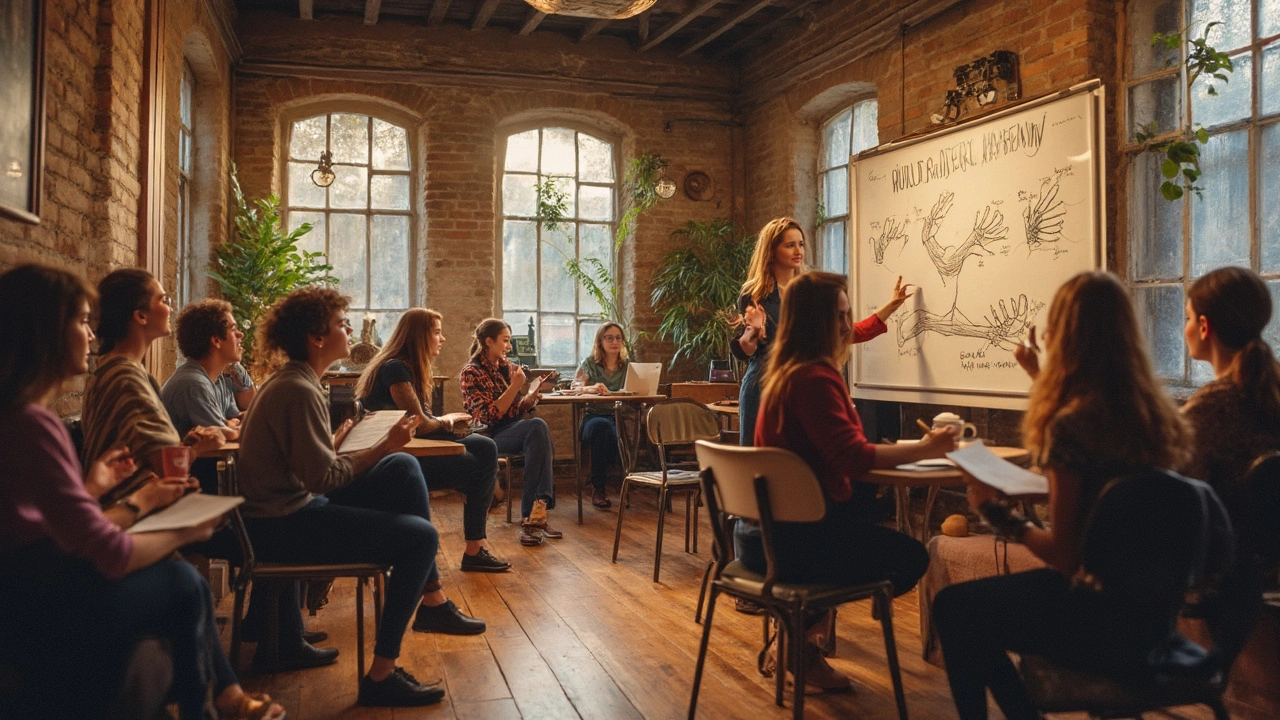Exploring massage courses in London can be a rewarding journey for beginners eager to learn and master new techniques. This guide covers essential tips for choosing the right course, understanding basic techniques, and gaining practical skills. With a robust market in London, there are diverse options suited for all learning preferences. Courses cater to complete beginners, focusing on a hands-on approach to ensure effective learning.

- Created by: Liam Redgate
- Completed on: 5 Feb 2025
- Categories: Education
So, you're thinking about diving into the world of massage and wondering where to start. London, with its bustling heart and diverse opportunities, might just be the perfect place for you. But why London, you ask? Well, it's not just about the vibrant city vibes; London offers a range of massage courses that cater specifically to beginners. You'll find courses that teach you everything from the basics to more advanced techniques, all while having the city at your fingertips.
As a beginner, the landscape might seem a bit daunting. You've got Swedish massage, deep tissue, aromatherapy, and plenty more. But don't fret! Most beginners' courses start with the essentials, gradually building your confidence and skill set. This structured approach ensures you're not overwhelmed from the get-go.
Now, selecting the right course is crucial. It's not just about picking what's popular or close by. You'll want to consider the curriculum, the instructors' expertise, and the hands-on experience offered. Remember, a solid foundation built on practice is what will truly set you apart.
- Why Choose London for Your Massage Course
- Basic Techniques Every Beginner Should Know
- Tips for Selecting the Right Course
- The Importance of Practice and Hands-on Experience
Why Choose London for Your Massage Course
London offers a unique blend of tradition and modernity, which makes it a fantastic place to pursue your massage education. It's not just the city's iconic sights and culture; London is a known hub for well-being and alternative health practices.
One reason to consider massage courses London is the sheer variety of options available. Whether you're interested in a holistic approach or more clinical methods, you'll find courses that cater to all preferences and specialties.
The Cultural Melting Pot
London's diverse population means you'll encounter people from all walks of life, which enriches your learning experience. This diversity translates into varied teaching methods and exposure to different massage styles and techniques.
Reputable Institutions
The city hosts several well-regarded institutions offering massage courses. From short workshops to comprehensive diploma programs, these schools guarantee quality education from experienced instructors.
Networking Opportunities
Studying in London means you'll have access to a vast network of professionals. You can attend workshops, seminars, and networking events, which can be incredibly beneficial as you start your career.
Statistics on Massage Therapists in London
| Aspect | Details |
|---|---|
| Number of Practitioners | Approximately 5,200 |
| Average Course Duration | 3 to 6 months |
| Median Salary | £25,000 per year |
In conclusion, if you're considering getting into massage therapy, London offers the right mix of quality education, diverse learning environments, and professional growth opportunities. It's a city that provides the ideal foundation for both beginners and seasoned learners to enhance their skills and advance in their massage careers.
Basic Techniques Every Beginner Should Know
Embarking on the journey of learning massage techniques begins with understanding the fundamental styles and movements that form the core of most practices. Whether you're in a structured massage course in London or practicing at home, mastering these basic techniques is essential.
Effleurage
Effleurage is typically the starting technique in many massages. It involves smooth, gliding strokes that help warm up the muscles and relax the body. Often used with oil or lotion, effleurage is key for promoting blood circulation and is a gentle introduction to more targeted techniques.
Petrissage
Moving beyond superficial layers, petrissage is where the therapist uses kneading motions to work into deeper layers of muscle tissue. This technique is effective for releasing muscle tension, improving flexibility, and enhancing overall relaxation.
Tapotement
While it might sound exotic, tapotement is simply rhythmic tapping or percussive movements. Using the edge of the hand or fingertips, it effectively stimulates nerve endings and increases blood flow, offering a refreshing change in pace during a massage session.
Additional Techniques to Explore
- Friction: Used with fingertips or thumbs in circular motions to generate heat and target deeper tissues.
- Vibration: Involves rapid shaking motions, ideal for soothing and relaxing after deeper work.
Remember, each technique serves a specific purpose and mastering them requires practice. In a typical beginners course, hands-on sessions will help in honing these skills effectively. For those eager to track their progress, here’s a snapshot of practice hours recommended for beginners:
| Technique | Recommended Practice Hours |
|---|---|
| Effleurage | 15-20 hours |
| Petrissage | 20-25 hours |
| Tapotement | 10-15 hours |
These hours can vary based on individual learning speeds, but they provide a beneficial benchmark as you navigate through your training journey. Ultimately, consistent practice and feedback are crucial in transforming these foundational skills into second nature.

Tips for Selecting the Right Course
Selecting the right massage course in London, especially for beginners, can seem like a daunting task. It requires careful consideration of multiple factors to ensure you get the most out of the experience. Here are some essential tips to guide you through this process.
Consider the Curriculum
Begin with a detailed look at the course curriculum. You'll want a program that covers the essentials, such as anatomy, basic massage techniques, and client care. Ensure the course is structured to gradually build your skills without overwhelming you at the start.
"A good course is one where you come out not just with the knowledge, but the confidence to apply it," says Grace Holloway, a renowned massage therapist in London.
Check Instructor Credentials
The expertise and teaching style of the instructors play a crucial role in your learning journey. Research their background, experience, and qualifications. Speaking to former students or reading reviews can provide insights into their teaching effectiveness and approachability.
Hands-On Experience is Key
Practical experience is invaluable in mastering massage techniques. Confirm that the course offers a significant amount of practical training alongside theoretical learning. Engaging directly with the techniques boosts your confidence and allows for constructive feedback.
Class Size Matters
Class size can impact the quality of education you receive. Smaller classes are often preferable as they offer a more personalized learning experience and direct access to instructors for questions and guidance.
Accreditation and Certification
Ensure the course is accredited by a recognized organization, which not only adds credibility to the training but may also be necessary for insurance purposes once you start practicing professionally.
Evaluate Course Costs
While cost is an important factor, it shouldn't be the sole determining one. Compare what each course offers for its price and consider the long-term value it adds to your career development. Look for options that offer a balance of quality instruction and affordability.
Location and Schedule
Finally, consider logistics such as the location of the class and the schedule. Ensure the timings align with your personal commitments, and the commute is manageable.
By thoughtfully considering these aspects, you'll be well on your way to selecting a massage course in London that meets your needs as a beginner and sets the stage for a successful career in massage therapy.
The Importance of Practice and Hands-on Experience
When it comes to mastering massage techniques, nothing beats the value of hands-on experience. Attending a course in London gives you direct access to real-life practice opportunities that are crucial for any aspiring therapist. Theories and techniques you read in books need to be applied under the guidance of experienced instructors; this is how true learning occurs.
Massage courses in London emphasize practical sessions. These courses are designed to ensure that learners spend a significant amount of time actually practicing different techniques on fellow students or volunteers under supervision. This approach is beneficial because it allows you to receive immediate feedback and correct mistakes on the spot, a critical aspect in becoming proficient.
The Value of Real-world Simulations
Many beginner courses implement real-world scenarios to prepare students for the professional environment. By simulating typical issues or situations therapists might encounter, beginners get a firsthand glimpse into the complexity and responsibility involved in providing effective care.
Benefits of Hands-on Practice
- Builds confidence: Constant practice boosts your ability to perform techniques with ease and assurance.
- Enhances understanding: By practicing consistently, you deepen your understanding of pressure points, muscle groups, and how to address specific issues effectively.
- Shows progress: As you practice, keeping track in practical sessions shows how much you’ve advanced and areas needing improvement.
Interestingly, a recent survey demonstrated that 87% of massage therapy students who engaged in hands-on practice felt significantly more prepared to enter the workforce compared to those who didn't.
Besides, the practice sessions often instill a sense of camaraderie among learners, making the experience more fulfilling. Working on various partners allows you to adapt to different body types and preferences, a skill that will be indispensable in professional settings.
Discover the science behind massage therapy, why having a massage therapist is key to your health, practical benefits, how to find trusted therapists in London, and what to expect in a session.
Scratch massages in London combine the soothing power of touch with a tantalizing sensation that invigorates the skin and entices the senses. This immersive experience is not only about relaxation but also about a heightened awareness of every stroke and caress. Dive into the world of scratch massage, where a feather-light touch meets a sensuous exploration of the body's surface. Discover tips, interesting facts, and hidden gems offering these intimate experiences in London.


